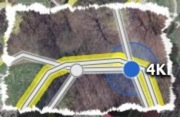routes
Make Route from Activity takes veeeery long
22/04/12 10:51 Filed in: Import
Problem: You have selected an activity and click on the make route button. TrailRunner becomes unresponsive and calculates for a very long time until the process is finished or seemingly never finishes.
Background: If you have already collected a network of track and merge new elements into it, the calculation of what is already there and what is similar and can be consolidated can be very time intensive.
 Suggestion: Please read the quick-guide tutorial and understand what way-point perimeters mean. If you can set up your network of tracks to contain landmarks with good perimeters, the operation above will be much faster.
Suggestion: Please read the quick-guide tutorial and understand what way-point perimeters mean. If you can set up your network of tracks to contain landmarks with good perimeters, the operation above will be much faster.
Workaround: The only alternative is to merge the track by hand (yellow sign) and then later recreate a route based on the spitted and joined tracks. This will also give you the opportunity to initially set up your way-point perimeters.
> QuickGuide Tutorlal
Background: If you have already collected a network of track and merge new elements into it, the calculation of what is already there and what is similar and can be consolidated can be very time intensive.

Workaround: The only alternative is to merge the track by hand (yellow sign) and then later recreate a route based on the spitted and joined tracks. This will also give you the opportunity to initially set up your way-point perimeters.
> QuickGuide Tutorlal
Importing GPX files as Activities, Routes and Tracks.
05/01/13 14:37 Filed in: Import
Problem: When you import a GPX file, the following intentions may be on your mind:
a) The GPX file you import is actually a recorded workout of your own (possibly containing heart-rate data), so it's an activity.
b) The file contains a route created by someone else and you want to add it to your own list of routes.
c) You are interested in the tracks and way-points contained in the file and you want to merge them into your network of tracks -- to be used in future routes you create.
Solution: when you import a GPX file, TrailRunner asks you if the file is to be imported as an activity or a route. Chose either option.
When you want to import the waypoints only, go to the Document Toolbar > Locations and import the file there.
Tip: For a better conceptual understanding of TrailRunner and the difference between tracks, routes and activities, take a look at the TrailRunner QuickGuide Tutorial
a) The GPX file you import is actually a recorded workout of your own (possibly containing heart-rate data), so it's an activity.
b) The file contains a route created by someone else and you want to add it to your own list of routes.
c) You are interested in the tracks and way-points contained in the file and you want to merge them into your network of tracks -- to be used in future routes you create.
Solution: when you import a GPX file, TrailRunner asks you if the file is to be imported as an activity or a route. Chose either option.
When you want to import the waypoints only, go to the Document Toolbar > Locations and import the file there.
Tip: For a better conceptual understanding of TrailRunner and the difference between tracks, routes and activities, take a look at the TrailRunner QuickGuide Tutorial
What's the difference between activities, workouts, routes, tracks and way-points?
22/12/10 09:37 Filed in: Conceptual
Problem: You have used other applications that import tracks and these never use vocabulary like activity, route or workout. Why is TrailRunner not using the same terms? And by the way, what is the difference between a track, an activity, a route and a workout?
Background: TrailRunner is more or less two applications in one: on the one hand a route planning application managing a personal network of tracks and on the other hand a journal for your sport activities. For your better understanding, please take a look at the TrailRunner QuickGuide. The differences should be obvious after you have read it. If not, please be so kind to let me know what you do not understand so I can improve either the QuickGuide or even TrailRunner.
> QuickGuide Tutorial
Background: TrailRunner is more or less two applications in one: on the one hand a route planning application managing a personal network of tracks and on the other hand a journal for your sport activities. For your better understanding, please take a look at the TrailRunner QuickGuide. The differences should be obvious after you have read it. If not, please be so kind to let me know what you do not understand so I can improve either the QuickGuide or even TrailRunner.
> QuickGuide Tutorial